“Give her the child; it’s always better if they see. Then they don’t imagine things.”
So I didn’t imagine. I remembered. (Dragonfly in Amber, ch. 28)
I would not say that I enjoyed watching Episode 207, “Faith.” However, it is together with Episode 206 the best of the season. In fact, it is an Emmy-worthy episode for the following reasons:
- Caitriona does a superb job in portraying the sadness and loss that women experience after a miscarriage. Personally, I have never miscarried a baby. However, people close to me had, and their emotional recovery was never easy. It is something that stays with them permanently.
- The use of a non-linear sequence of events. Most of the episode’s narration is in retrospective.
- The interaction between Claire and Jamie is an excellent instance of character development, a characteristic that is usually neglected in TV adaptations.
- A script that contains emotionally intense scenes and meaningful comments.
- Events and emotions are representative of those in real life.
- Remarkable costume design and scene settings.
- Actors with secondary roles excel in their portrayals.
The Healing
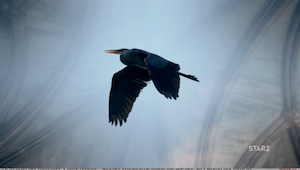
The opening scene consists of a young Brianna in Boston, 1954, reading a variety of books about birds. She asks her mother whether she has seen a heron at all. Claire replies that she saw one in Scotland “a long time ago.” Her daughter’s question brings back memories of the stillbirth, the subsequent infection, and the healing process, both physical and emotional.
In the next scene, we are transported back to the eighteenth century. Claire is at the charity hospital giving birth. Of course, the usual joy that mothers experience is absent. In fact, she is delirious and suffering. Claire’s vision is blurred. Mother Hildegarde is saying soothing comments and Sister Angelique is praying. Monsieur Forez is the “obstetrician.” At the same time, Claire is having visions of a heron flying. Of note is the presence of a statue of Virgin Mary wearing the blue cloak. After the operation, there is a moment in which she gathers enough strength and realizes that the baby is out. She is in disbelief and starts asking for the child. Her emotions grow out of control to the point that she topples the statue of Virgin Mary. Of course, the Virgin is not comfort to Claire. At this time, the viewer believes that Claire was not able to see or hold her child, and starts asking himself or herself its consequences. In the following scene, Mother Hildegarde tells Claire that she had the baby baptized by the name of Faith so that she can be buried in holy ground, a secret that must be kept between them and God. Those who were born dead did not receive baptismal rites. Mother Hildegarde also brings a priest to perform the Sacrament of the Unction of the Sick, a perfect indicator that Claire is about to die. In fact, Claire has a puerperal fever due to placental remains inside her. When the priest asks Claire to confess, her comment transmits her feelings of loss and despair: “My sins are all that I have left.”
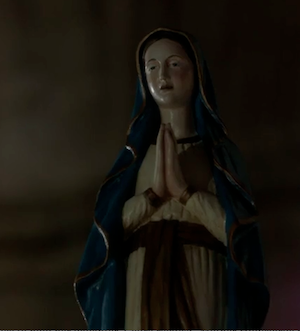
When Claire is by herself with Bouton, Raymond appears. He massages Claire’s face, and he asks her what she sees, which turns out to be blue wings. Raymond reveals that blue is the color of healing. He continues touching and applying pressure to Claire’s body. Of note is Claire’s description of how she feels the destruction of all the pockets of bacterial infection as Raymond lightly presses her body. Towards the end of this procedure, he asks Claire to call the red man. Claire screams Jamie’s name as the piece of placenta is being removed from her body. The healing is instantaneous, and the recovery is fast. Raymond leaves before Sister Angelique comes and starts claiming that a “miracle” has happened. The truth is that Raymond performs miracles when he heals. Of note is the fact that Bouton obeys everything that Raymond says to him, like if he were Mother Hildegarde.
The Mother
In the scene in which Claire receives the Unction of the Sick, she tells the priest that her sins are everything she has with her based on her belief that she has lost everything. She does not realize that she has people who need her and appreciate her. I guess one of the problems with Claire this season is that she sees everything that is close to her and does not want to look what lies beyond. Before she leaves the hospital, she muses about how her body has healed, but her soul has not. Then, Fergus asks her to come home and brings her “blue” flowers, probably a hint that Claire’s soul will heal too. When she arrives home, everybody is at grief. Suzette cries and kisses her hand, and Claire bows to Magnus. It was a scene that reflects the sorrow, the loss and the servants’ appreciation for Claire. Furthermore, there are no social barriers in times of mourning.
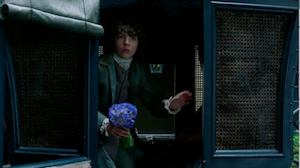
There is a mother-child relationship between Fergus and Claire in this episode. Finally, the audience gets to see Fergus combing Claire’s hair. The camera emphasizes Fergus’s discomfort when gazing at the perfume oils at Claire’s vanity table, a hint that something went wrong in his encounter with a Redcoat. He dreams about it, and Claire comes to him when he is having one of these nightmares. Fergus reveals that Captain Randall raped him, and Jamie came to his rescue and challenged Black Jack to a duel. Apparently, Jamie did not want Black Jack’s actions to go unpunished. It is hard for Fergus to reveal what Black Jack did to him. First, he feels shame. Second, he blames himself for Jamie’s incarceration. In real life, people find it hard to reveal these feelings and emotions, and that is why Fergus sees Claire as a mother. Furthermore, Fergus pickpocketed Black Jack’s perfume oil because he wanted to give it as a gift to Claire, another hint that he sees Claire as somebody close to him. At the same time, confessing that he was stealing something is not easy. One cannot forget that Fergus was concerned about the consequences of his actions when Jamie met him. Fergus’s revelation is a “wake up” call to Claire, who has been oblivious that people around her need her. Those who know her and care for her are from different social backgrounds (Magnus and Louise de la Tour). No wonder Claire blames herself for stopping Jamie in killing Black Jack. Suffering could have been prevented if Jamie had killed Black Jack earlier. She has endangered everybody to ensure the survival of a husband who is no longer part of her life.
La Dame Blanche
After learning the truth of Jamie’s incarceration, Claire starts thinking how to get Jamie free. Of note is her revelation to Mother Hildegarde in regards to having sex with the King: “If it comes to sacrifice my virtue, I will add it to the list of things I have lost in Paris.” The subsequent dialogue between her and Louis is faithful to the one in the books. One addition in the adaptation is Louis’s inquiry about Claire wedding bands. In this scene, Louis probably realizes that Claire can be trusted since she is wearing the ring of a “dead” husband. Louis describes it as loyalty and becomes aware that Claire’s decision to give herself to him is a great sacrifice. There is also the fear in Claire’s musing that Louis can do whatever he wants with her because of his position as an absolute monarch. There is a reference to Claire’s pale skin color; a praised physical characteristic back then, and one of the reasons why she is called “La Dame Blanche.” Subsequently, Louis takes her to the round room where he practices astrology. Claire is asked to decide the fate of the accused, St. Germain and Master Raymond. As “La Dame Blanche,” Claire is not a proficient liar. Her face reveals the truth. She also tells the truth no matter the consequences. In fact, TV Louis uses lines similar to those in book 2 in describing the qualities of “La Dame Blanche.”
“. . . An infallible judge of truth, of purity of heart.”
“La Dame Blanche cannot lie; she sees the heart and the soul of a man, and may turn the truth to good . . . or to destruction” (Dragonfly in Amber, ch. 27).
Claire feels uncomfortable for being the judge in this trial. She is aware that St. Germain is associated with “Les Disciples.” Furthermore, he reveals that he tried to poison her. He strives to make Claire look bad by saying that she is a witch since she survived the poisoning attempt. This scene reveals the real St. Germain. He is emotional and does not hesitate to say what he thinks/feels. Apparently, he does not see far ahead when he reveals that he tried to kill Claire, something that should not be mentioned in a trial. However, is he behind the attack against Mary, Claire, and Murtagh? St. Germain was seated peacefully at the dinner afterward. He was not even upset to see Claire alive. In fact, he was relaxed, an unusual characteristic for somebody who does not hide his feelings. This is probably the reason why Claire muses that she finds it hard to condemn him to death. Of course, her healing nature plays a role – she cures both enemies and loved ones. Furthermore, the TV adaptation has made it clear that there is an association between Sandringham and St. Germain, subtlety in the books. Louis, who seems to be a skilled reader of people, disregards St. Germain’s claims against Claire. Subsequently, she mentions that she sees darkness in St. Germain’s soul. She explains that Raymond’s soul is also dark, but that this darkness is typical, the type present in everybody. Of course, she gazes at Monsieur Forez immediately, who is proud of his skills as the Royal Executioner, and then to Louis. Claire moves in an intimidating manner in this scene.
Louis tries to aid Claire by bringing a serpent in, a way to have a spectacle in which somebody may be mortally wounded. Claire convinces him to use poison instead. The person who survives the poison is innocent. Of course, she plans to give bitter cascara to the accused and save them. Raymond drinks and drops to his knees. It is at this moment in which he poisons the drink without being detected. As Claire raises the cup, the opal changes color to black, an indication that she is holding a contaminated drink. St. Germain realizes what he is about to drink. He hesitates but drinks it nonetheless. He dies instantaneously. Of note is the fact that he did not believe that the opal was sensitive to poison, as demonstrated in his statement at the dinner scene in Episode 204, “La Dame Blanche.” The change of color in the stone comes as a shock to him. Raymond is set free but told to leave France. Similarly, Claire has to leave since she is associated with witchcraft too. The sex scene between Louis and her is a business transaction as in the books.
What I like about the trial scene overall is that Claire has a more active role than in the books. In Dragonfly in Amber, she is aided by Raymond. In the adaptation, she takes the initiative, and Raymond helps her in a subtle manner.
The Reunion
In the books, Raymond’s healing is what makes Claire realize that Jamie saved her life once more. Claire muses:
But I had come back from the dead. Only Jamie’s hold on my body had been strong enough to pull me back from that final barrier, and Master Raymond had known it. I knew that only Jamie himself could pull me back the rest of the way, into the land of the living. That was why I had run from him, done all I could to keep him away, to make sure he would never come near me again. I had no wish to come back, no desire to feel again. I didn’t want to know love, only to have it ripped away once more (Dragonfly in Amber, ch. 28).
Is this realization another of the reasons that push Claire to blame herself for everything that has gone wrong in her relationship with her husband? She placed extreme importance on Frank’s survival as opposed to Jamie, the man who is a life force behind her, and their daughter. Jamie emphasizes that there is nothing to forgive. Nobody is to be blamed, not even Frank. He mentions that he has forgiven her everything for a long time, a line that resembles Jamie’s musing in the opening scene of “The Reckoning.” He has forgiven her because of love. Jamie’s comments are comforting. He knows what to say, and one wonders whether his religious beliefs play a role. He acknowledges that the burden that Claire carries cannot be borne by her only; they must bear it together. This concept of being together and supporting each other during and after a crisis is what makes a marriage long-lasting.
To secure the release of her husband, Claire also confesses that she slept with the King. Jamie is not upset about this. He sees it as a sacrifice that Claire did to save him, similar to his decision of giving his body to Black Jack to ensure Claire’s safety at Wentworth. Of course, this argument supports Jamie’s comments in which he makes it clear that the has forgiven Claire before their misfortunes in Paris. It also links the experiences that both characters share in giving their bodies unwillingly. In the books, there is also a link between these two similar experiences. Jamie is upset with Claire because she thought that sleeping with Louis would make him not want her anymore. This logic bothers Jamie. After Wentworth, Jamie thought that Claire would not want him, but Claire opted to remain with him. Therefore, it does not make sense to him that Claire thought that sleeping unwillingly with another man would get him to go away. As a result, the adaptation still creates a link between the unpleasant sexual experiences that both Jamie and Claire share without the need of the nettles scene, streamlining the storyline efficiently. In fact, I do not miss the nettles scene much, especially after watching Claire hiding information from Jamie for a few episodes.
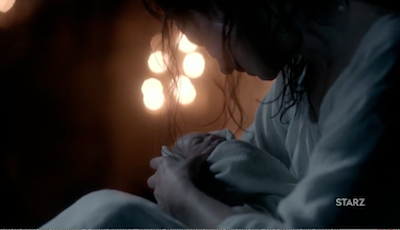
Claire also provides a description of her daughter. It is in this flashback in which the viewer learns that Claire was given the chance to hold her daughter. Claire relates: “Mother Hildegarde made me see her, so I would not have to imagine.” The physical description of Faith is full of tenderness and similar to the one of the books, except for the color of the hair, copperhead (addition). Louise de la Tour also makes an appearance to offer her condolence, showing a more compassionate aspect of her. She is a true friend.
The closing scene in which both parents are visiting their daughter’s grave is beautifully filmed. I like the detail in which Jamie leaves her a silver spoon, a gift.
If you are interested in learning more about Master Raymond and his association with Claire, here is a link to a post that I wrote for Outlander Central.
St. Raymond, the Shaman, and his Association with Claire
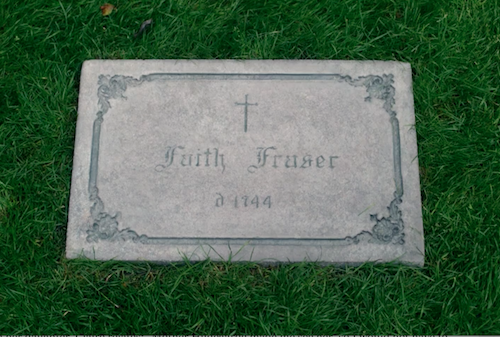
Love hearing your insight!
Herons look very much like storks. Do you know if they share any symbolism?
They look similar even in their coloring. They belong to different families, though: http://the-difference-between.com/heron/stork. They fly differently too. https://answers.yahoo.com/question/index?qid=20080919104706AAo0ywr. I guess the trick is the color, which is blue and the requirement for Claire’s spiritual and physical healing. The fact that the bird is flying may represent that Claire’s life is “fleeting,” her frail health at that moment. Later, she mentions that her body has healed, but her soul has not. There are references in the book where she muses that she does not want to live anymore after losing her daughter and her husband. It is a condition similar to Jamie’s after Wentworth. I guess that she would always remember what happened to her, but at least she would have a husband and people around her that would offer her moral support and love to get through this sad experience.